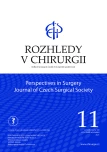Midgut volvulus in adult age associated with congenital malrotation – case report
Authors:
Š. Kolcún; T. Malý; M. Stašek
Authors‘ workplace:
I. chirurgická klinika Fakultní nemocnice Olomouc
Published in:
Rozhl. Chir., 2021, roč. 100, č. 11, s. 559-562.
Category:
Case Report
doi:
https://doi.org/10.33699/PIS.2021.100.11.559–562
Overview
Introduction: Malrotation is understood as a congenital anomaly of the intestinal position formed during embryonic development. Disorders of intestinal rotation and its manifestations in adulthood are less common; the symptoms of these disorders are characteristic of childhood. An asymptomatic bowel rotation disorder occurs in up to 1 of 200 newborns and symptomatic malrotation occurs in 1 of 6,000 live newborns. The incidence of intestinal rotation disorders in adulthood is estimated to be between 0.0001% and 0.19%. Acute complications in adulthood include volvulus with ischemia of the small bowel.
Case report: A 36-year-old man with a previously diagnosed bowel rotation disorder with intermittent abdominal pain was examined for sudden convulsive pain. The CT scan showed volvulus of small bowel. During surgery, a small bowel volvulus with venostasis and dilated mesenteric veins rotated 360 degrees clockwise, the mesenterium commune, and the presence of Ladd’s bands causing partial compression of the duodenum were found. The condition was managed surgically to derotate the loops into nonrotation with preserved viability of the intestinal loops, interrupt the Ladd’s bands and mobilize the duodenum, including fixation of the mesentery to the retroperitoneum and invagination appendectomy. The patient has been without problems and without any signs of complications based on his 2-year follow-up from the surgery.
Conclusion: Early surgical treatment of intestinal malrotation complications helps maintain intestinal viability and can prevent the development of the short bowel post-resection syndrome. Prophylactic surgery should be considered in symptomatic rotation disorders, although the determination of the indication for surgery and its timing remain uncertain.
Keywords:
adult − midgut − malrotation − acute abdomen
Sources
1. Kluth D, Jaeschke-Melli S, Fiegel H. The embryology of gut rotation. Semin Pediatr Surg. 2003;12(4):275–279. doi:10.1053/j.sempedsurg.2003.08.009.
2. Hartman GE. Intestinal obstruction. In: Stevenson DK, Cohen RS, Sunshine P, editors. Neonatology: clinical practice and procedures. New York, McGraw-Hill; 2015. Available at: http://accesspediatrics. mhmedical.com/content.aspx?bookid= 1462&Sectionid=85592341. ISBN 978 - 0-07-176376-9.
3. Christison-Lagay E, Langer JC. Intestinal rotation abnormalities. In: Ziegler MM, Azizkhan RG, Allmen D, Weber TR, editors. Operative pediatric surgery. 2nd ed. New York, McGraw-Hill; 2014. Available at: http://accesssurgery. mhmedical.com/content.aspx? bookid= 959&Sectionid=53539609. ISBN 978 - 0-07-162723-8.
4. Durkin ET, Lund DP, Shaaban AF, et al. Agerelated differences in diagnosis and morbidity of intestinal malrotation. J Am Coll Surg. 2008;206(4):658–663. doi:10.1016/j.jamcollsurg.2007.11.020.
5. Von Flüe M, Herzog U, Ackermann C, et al. Acute and chronic presentation of intestinal nonrotation in adults. Dis Colon Rectum. 1994 Feb;37(2):192–198. doi:10.1007/BF02047549.
6. Wang CA, Welch CE. Anomalies of intestinal rotation on adolescents and adults. Surgery 1963 Dec; 54 : 839−855. PMID: 14087118.
7. McVay M, Kokoska ER, Jackson RJ, et al. The changing spectrum of intestinal malrotation: diagnosis and management. Am J Surg. 2007;194(6):712–719. doi:10.1016/j.amjsurg.2007.08.035.
8. Neville JJ, Gallagher J, Mitra A, et al. Adult presentations of congenital midgut malrotation: A systematic review. World J Surg. 2020 Jun;44(6):1771−1778. doi:10.1007/s00268-020-05403-7.
9. Adams SD, Stanton MP. Malrotation and intestinal atresias. Early Hum Dev. 2014 Dec;90(12):921−925. doi:10.1016/j.earlhumdev. 2014.09.017.
10. Yousefzadeh DK, Kang L, Tessicini L. Assessment of retromesenteric position of the third portion of the duodenum: an US feasibility study in 33 newborns. Pediatr Radiol. 2010 Sep;40(9):1476−1484. doi:10.1007/s00247-010-1709-4.
11. Esposito F, Vitale V, Noviello D, et al. Ultrasonographic diagnosis of midgut volvulus with malrotation in children. J Pediatr Gastroenterol Nutr. 2014 Dec;59(6):786−788. doi:10.1097/ MPG.0000000000000505.
12. Pickhardt PJ, Bhalla S. Intestinal malrotation in adoles-cents and adults: spectrum of clinical and imaging features. AJR Am J Roentgenol. 2002;179 : 1429−1435. doi:10.2214/ajr.179.6.1791429.
13. Tackett JJ, Muise ED, Cowles RA. Malrotation: current strategies, navigating the radiologic diagnosis of a surgical emergency. World J Radiol. 2014;6(9):730−736. doi:10.4329/wjr.v6.i9.730.
14. Kiely EM, Pierro A, Pierce C, et al. Clot dissolution: a novel treatment of midgut volvulus. Pediatrics 2012 Jun;129(6):e1601−1604. doi:10.1542/ peds.2011-2115.
15. Palanivelu C, Rangarajan M, Shetty AR, et al. Intestinal malrotation with midgut volvulus presenting as acute abdomen in children: value of diagnostic and therapeutic laparoscopy. J Laparoendosc Adv Surg Tech A. 2007 Aug;17(4):490−492. doi:10.1089/lap.2006.0103.
16. El-Gohary Y, Alagtal M, Gillick J. Longterm complications following operative intervention for intestinal malrotation: a 10-year review. Pediatr Surg Int. 2010 Feb;26(2):203−236. doi:10.1007/s00383 - 009-2483-y.
17. Frasier LL, Leverson G, Gosain A, et al. Laparoscopicversus open Ladd’s procedure for intestinal malrotation in adults. Surg Endosc. 2015;29 : 1598−604. doi:10.1007/s00464-014-3849-3.
18. Kotobi H, Tan V, Lefèvre J, et al. Total midgut volvulus in adults with intestinal malrotation. Report of eleven patients. Journal of Visceral Surgery 2017;154(3):175–183. doi:10.1016/j.jviscsurg. 2016.06.010.
19. Berger RB, Hillemeier AC, Stahl RS, et al. Volvulus of the ascending colon: an unusual complication of non-rotation of the midgut. Pediatr Radiol. 1982;12 : 298–300. doi:10.4329/wjr.v4.i10.439.
Labels
Surgery Orthopaedics Trauma surgeryArticle was published in
Perspectives in Surgery

2021 Issue 11
Most read in this issue
- Total mesorectal excision for rectal cancer – laparoscopic versus robotic approach
- Midgut volvulus in adult age associated with congenital malrotation – case report
- TaTME (transanal total mesorectal excision) – state of the art
- Quality of life after transanal total mesorectal excision – our experience
